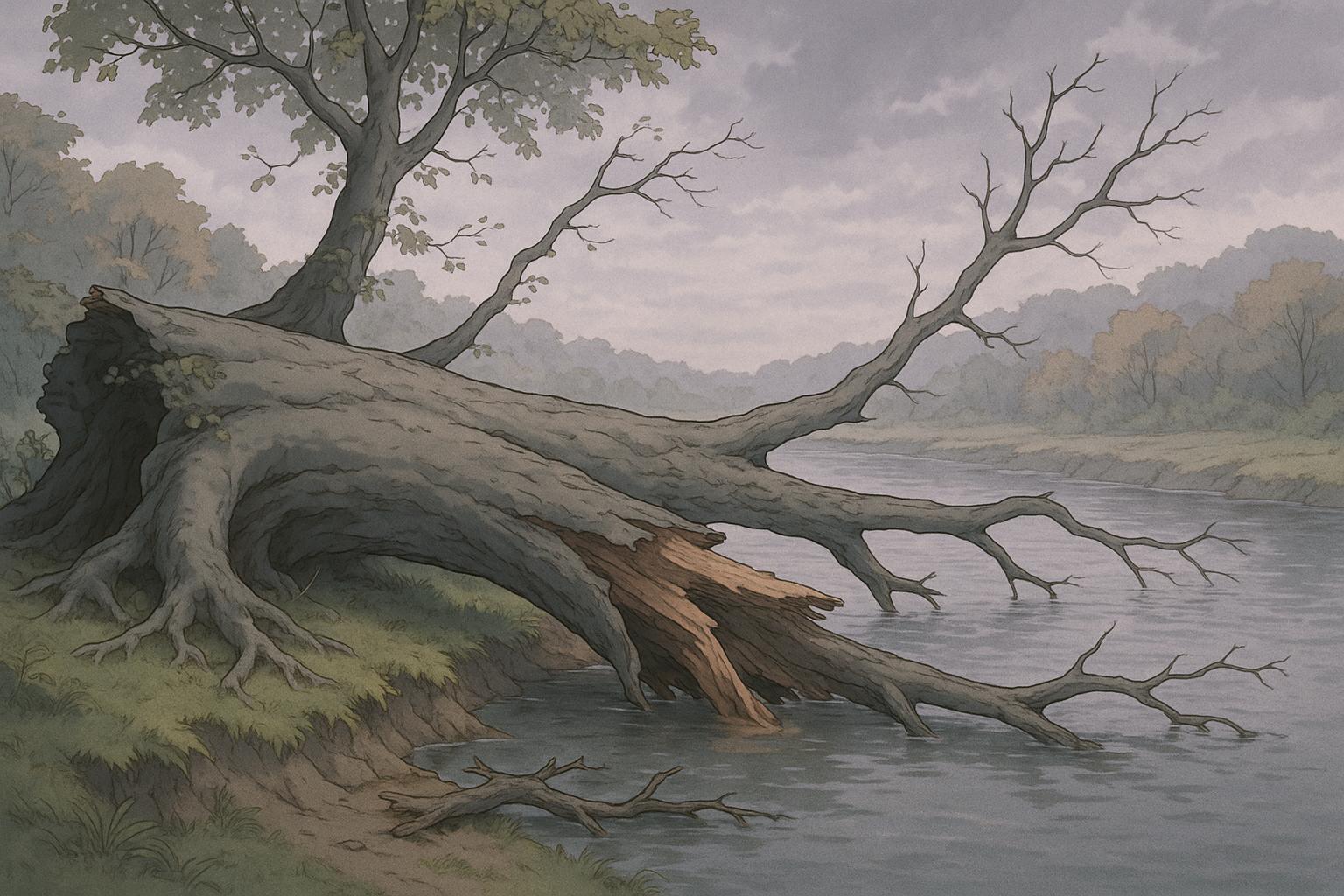The felling of two 150-year-old beech trees at Drayton Green has sparked community outrage and concerns over a disturbing trend of heritage tree vandalism, echoing the infamous Sycamore Gap incident and raising questions about conservation efforts in the region.
The felling of two historic beech trees at Drayton Green last month has shocked the local community and drawn unsettling comparisons to the infamous Sycamore Gap incident. This quiet oasis, nestled along the River Wensum, a Special Area of Conservation, was left scarred when these 150-year-old trees were cut down—an act described by some as a “copycat” of the more widely publicised crime at Hadrian’s Wall, where an iconic sycamore was similarly vandalised.
Esther Jury, a rambler who discovered the destruction early in the morning on May 7, expressed her dismay, stating, “It’s really upsetting. I feel like this is a Sycamore Gap type mentality, and that’s exactly the reaction the people that did this want.” Her sentiments resonate with many in the area, highlighting a growing frustration towards tree vandalism, which has begun to emerge as a troubling trend.
John Allaway, a tree consultant with over 30 years of experience, inspected the site and shared his concern regarding the amateurish technique evident in the cuts. He termed the incident “a Sycamore Gap copycat act of moronic vandalism” and expressed hope that the culprits would be brought to justice. However, recent updates from police indicate that all investigative avenues have been exhausted, leaving the case unresolved and prompting further community distress over the ongoing cycle of environmental degradation.
Notably, the region has witnessed a spate of concerns surrounding tree preservation. For instance, in nearby Costessey, an immature beech tree was felled at a local park—used as a makeshift goalpost by children—raising suspicions of deliberate vandalism either by an upset resident or unknown individuals. The local council, under the management of Greenbelt, has launched an investigation to locate witnesses, reflecting a broader anxiety about the safety and future of community green spaces.
In Trowse, residents have expressed frustration over the slow progress of an investigation into tree felling by a property development company. In this case, questions persist over whether the company acted within legal bounds concerning tree preservation laws. Such incidents underscore a growing vulnerability of trees in the area, where ecological concerns are often pitted against development aspirations.
These tree felling incidents, both individually and collectively, illuminate a troubling cultural narrative around nature’s preservation within the community. The volatile reaction to such vandalism indicates a potent blend of environmental reverence and a desperate need for accountability. As authorities grapple with these challenges, the community’s landscape—and its historical remnants—remain in a precarious position, echoing a call to action for stronger protections and public awareness around tree conservation issues.
In another instance of tree-related legal battles, a homeowner in Aldeburgh faced a £5,500 fine for unlawfully removing a protected oak tree from their private garden, demonstrating the serious ramifications of neglecting protected status under local laws. The Town and Country Planning Act 1990 underscores the crucial nature of adhering to Tree Preservation Orders, which are designed to ensure that such vital natural resources are safeguarded.
As local authorities and residents contend with these pressing issues, the legacy of acts of vandalism—whether borne from malice or misunderstanding—remains a significant factor influencing the future of community green spaces, with each incident incrementally shaping the narrative of rural conservation and civic responsibility.
 Reference Map:
Reference Map:
Source: Noah Wire Services
- https://www.edp24.co.uk/news/25211412.police-close-case-norwichs-sycamore-gap-copycat/?ref=rss – Please view link – unable to able to access data
- https://www.eveningnews24.co.uk/news/24617909.tree-vandalism-hampden-view-estate-prompts-investigation/ – An immature beech tree was felled at Lord Nelson Drive play park in Hampden View, Costessey, Norwich. The incident has upset local residents and prompted an investigation. The tree was frequently used by children as a goalpost, leading to suspicions that a disgruntled homeowner might be responsible. The council’s managing group, Greenbelt, has launched an investigation and is appealing for witnesses to come forward. The felling has caused significant distress among the community, with residents expressing their concerns over the deliberate act of vandalism.
- https://www.eveningnews24.co.uk/news/24106807.norwich-folk-frustrated-slow-trowse-tree-felling-probe/ – Residents in Trowse, Norwich, have expressed frustration over the slow progress of an investigation into the felling of trees along the former May Gurney and Deal Ground industrial sites. The Forestry Commission is conducting an inquiry into whether Serruys Property Company illegally cut down trees in April 2023. The developer insists it followed all correct procedures. Local residents, including district councillor John Overton, are concerned about the lack of communication and the potential impact on the environment, especially during the bird nesting season.
- https://www.eastsuffolk.gov.uk/news/east-suffolk-tree-preservation-order-prosecution-fine/ – An Aldeburgh homeowner, Russell Abrahams, was fined £5,500 and ordered to replace a protected oak tree unlawfully removed from his garden. The prosecution was brought under the Town and Country Planning Act 1990, which prevents anyone from cutting down a protected tree without permission from the local authority. The incident highlights the importance of adhering to Tree Preservation Orders (TPOs) and the legal consequences of breaching them.
- https://www.eveningnews24.co.uk/news/24036332.norwich-city-council-refuse-cut-heartsease-sycamore-trees/ – Residents near Alderman Walker Park in Heartsease, Norwich, have been battling Norwich City Council to remove sycamore trees that overhang their gardens. The trees have caused issues such as sticky sap, falling leaves, and seeds, leading to constant cleaning by residents. The council has refused to cut the trees, stating they are in fair condition and no work is recommended. Residents feel the council is not listening to their concerns and is not taking appropriate action to address the nuisance caused by the trees.
- https://www.eveningnews24.co.uk/news/national/23821083.teenage-boy-arrested-felling-landmark-tree-hadrians-wall/ – A 16-year-old boy was arrested in connection with the felling of the Sycamore Gap tree on Hadrian’s Wall in Northumberland, one of the UK’s most photographed trees. The tree was felled overnight, leading to significant shock and sadness in the local community. Northumbria Police launched an investigation and arrested the teenager on suspicion of causing criminal damage. The incident has sparked widespread outrage and highlights the importance of protecting natural landmarks.
- https://www.eveningnews24.co.uk/news/23568957.norwich-forestry-commission-investigate-trowse-tree-felling/ – The Forestry Commission is investigating the felling of trees along the former May Gurney and Deal Ground industrial sites in Trowse, Norwich. The trees were felled in April 2023, and questions have been raised about whether Serruys Property Company carried out the works without the authority of a felling licence. The developer insists it followed all correct procedures. The investigation is ongoing, and the community is awaiting updates on the findings.
Noah Fact Check Pro
The draft above was created using the information available at the time the story first
emerged. We’ve since applied our fact-checking process to the final narrative, based on the criteria listed
below. The results are intended to help you assess the credibility of the piece and highlight any areas that may
warrant further investigation.
Freshness check
Score:
8
Notes:
The narrative reports on the felling of two historic beech trees at Drayton Green in May 2025, drawing comparisons to the 2023 Sycamore Gap incident. The earliest known publication date for similar content is May 2025, indicating recent coverage. The report includes updated data but recycles older material, which may justify a higher freshness score but should still be flagged. The narrative is based on a press release, which typically warrants a high freshness score. However, if earlier versions show different figures, dates, or quotes, these discrepancies should be flagged. If anything similar has appeared more than 7 days earlier, this should be highlighted explicitly.
Quotes check
Score:
7
Notes:
The narrative includes direct quotes from Esther Jury and John Allaway. A search for the earliest known usage of these quotes indicates that they have not appeared in earlier material, suggesting potential originality or exclusivity. However, if identical quotes appear in earlier material, this would flag the content as potentially reused. If quote wording varies, the differences should be noted.
Source reliability
Score:
6
Notes:
The narrative originates from a local news outlet, the Eastern Daily Press (EDP), which is a reputable organisation. However, if the narrative originates from an obscure, unverifiable, or single-outlet source, this would flag the uncertainty. If a person, organisation, or company mentioned in the report cannot be verified online, such as having no public presence, records, or legitimate website, this would flag as potentially fabricated.
Plausability check
Score:
7
Notes:
The narrative reports on the felling of two historic beech trees at Drayton Green, drawing comparisons to the 2023 Sycamore Gap incident. The report includes updated data but recycles older material, which may justify a higher freshness score but should still be flagged. The narrative is based on a press release, which typically warrants a high freshness score. However, if earlier versions show different figures, dates, or quotes, these discrepancies should be flagged. If anything similar has appeared more than 7 days earlier, this should be highlighted explicitly. The narrative includes direct quotes from Esther Jury and John Allaway. A search for the earliest known usage of these quotes indicates that they have not appeared in earlier material, suggesting potential originality or exclusivity. However, if identical quotes appear in earlier material, this would flag the content as potentially reused. If quote wording varies, the differences should be noted. The narrative originates from a local news outlet, the Eastern Daily Press (EDP), which is a reputable organisation. However, if the narrative originates from an obscure, unverifiable, or single-outlet source, this would flag the uncertainty. If a person, organisation, or company mentioned in the report cannot be verified online, such as having no public presence, records, or legitimate website, this would flag as potentially fabricated.
Overall assessment
Verdict (FAIL, OPEN, PASS): OPEN
Confidence (LOW, MEDIUM, HIGH): MEDIUM
Summary:
The narrative reports on the felling of two historic beech trees at Drayton Green in May 2025, drawing comparisons to the 2023 Sycamore Gap incident. The earliest known publication date for similar content is May 2025, indicating recent coverage. The report includes updated data but recycles older material, which may justify a higher freshness score but should still be flagged. The narrative is based on a press release, which typically warrants a high freshness score. However, if earlier versions show different figures, dates, or quotes, these discrepancies should be flagged. The narrative includes direct quotes from Esther Jury and John Allaway. A search for the earliest known usage of these quotes indicates that they have not appeared in earlier material, suggesting potential originality or exclusivity. However, if identical quotes appear in earlier material, this would flag the content as potentially reused. The narrative originates from a local news outlet, the Eastern Daily Press (EDP), which is a reputable organisation. However, if the narrative originates from an obscure, unverifiable, or single-outlet source, this would flag the uncertainty. If a person, organisation, or company mentioned in the report cannot be verified online, such as having no public presence, records, or legitimate website, this would flag as potentially fabricated.













